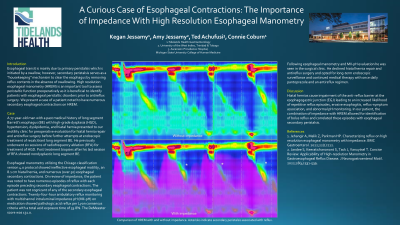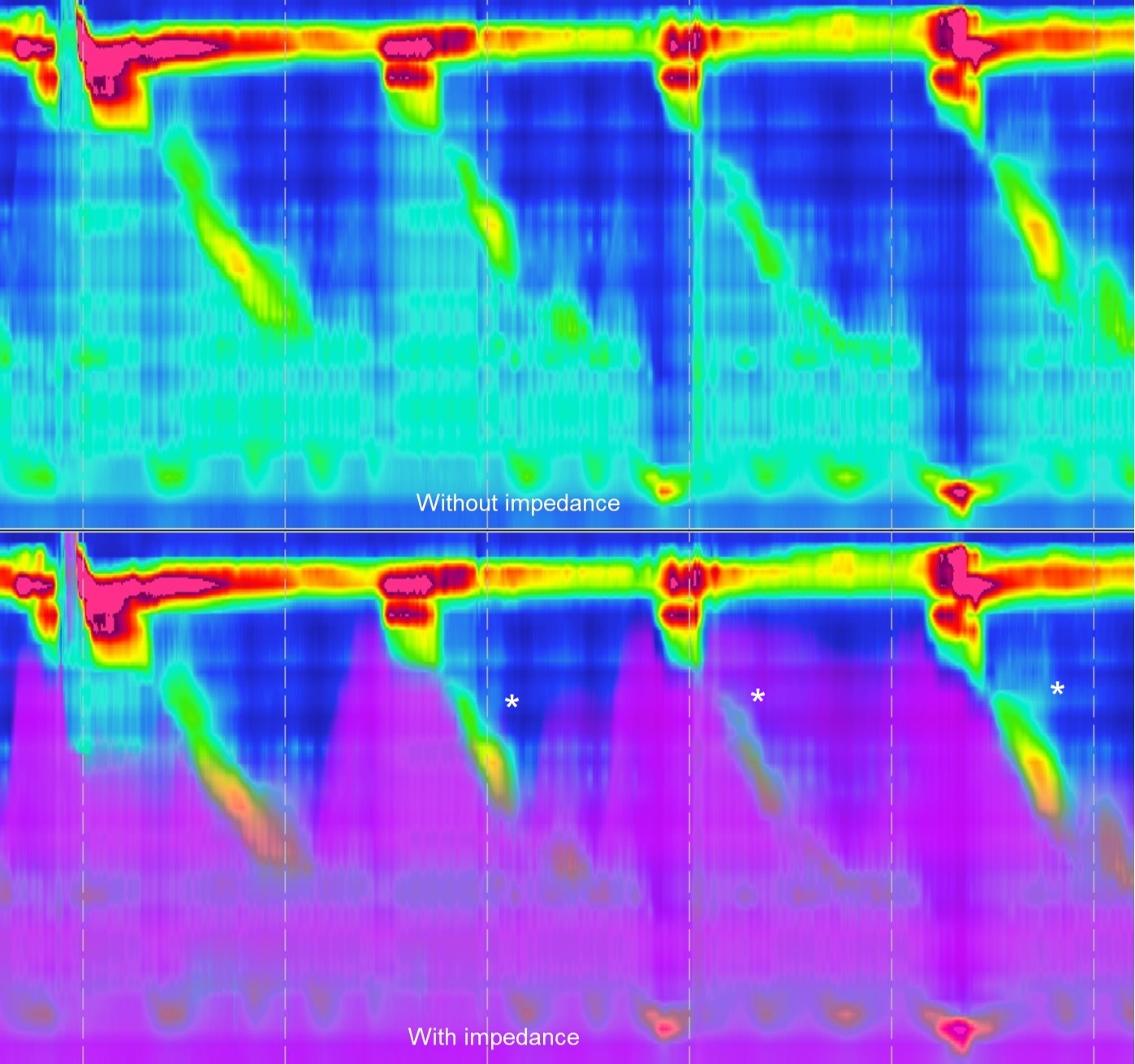Monday Poster Session
Category: Esophagus
P1870 - A Curious Case of Esophageal Contractions: The Importance of Impedance With High Resolution Esophageal Manometry
Monday, October 23, 2023
10:30 AM - 4:15 PM PT
Location: Exhibit Hall

Has Audio
- KJ
Kegan Jessamy, MD
Tidelands Health Gastroenterology
Georgetown, SC
Presenting Author(s)
Kegan Jessamy, MD1, Amy Jessamy, BSc2, Ted Achufusi, MD3, Connie Coburn, RN, MS4
1Tidelands Health Gastroenterology, Georgetown, SC; 2University of the West Indies, St. Augustine, Tunapuna-Piarco, Trinidad and Tobago; 3Ascension Providence, Southfield, MI; 4Tidelands Health Gastroenterology, Murrells Inlet, SC
Introduction: Esophageal transit is mainly due to primary peristalsis which is initiated by a swallow, however, secondary peristalsis serves as a "housekeeping" mechanism to clear the esophagus by removing reflux contents in the absence of swallowing. High resolution esophageal manometry (HREM) is an important tool to assess peristaltic function preoperatively as it is beneficial to identify patients with esophageal peristaltic disorders prior to antireflux surgery. We present a case of a patient noted to have numerous secondary esophageal contractions on HREM.
Case Description/Methods: A 77-year-old man with a past medical history of long segment Barrett's esophagus (BE) with high-grade dysplasia (HGD), hypertension, dyslipidemia, and hiatal hernia presented to our motility clinic for preoperative evaluation for hiatal hernia repair and antireflux surgery before further attempts at endoscopic treatment of recalcitrant long segment BE. He previously underwent six sessions of radiofrequency ablation (RFA) for treatment of HGD. Post treatment biopsies after his last session of RFA showed nondysplastic long segment BE.
Esophageal manometry utilizing the Chicago classification version 4.0 protocol showed ineffective esophageal motility, an 8.1 cm hiatal hernia, and numerous (over 50) esophageal secondary contractions. On review of impedance, the patient was noted to have numerous episodes of reflux with each episode preceding secondary esophageal contractions. The patient was not cognizant of any of the secondary esophageal contractions. Twenty-four-hour ambulatory reflux monitoring with multichannel intraluminal impedance pH (MII-pH) on medication showed pathologic acid reflux per Lyon consensus criteria with a total acid exposure time of 33.8%. The DeMeester score was 131.0.
Following esophageal manometry and MII-pH evaluation he was seen in the surgical clinic. He declined hiatal hernia repair and antireflux surgery and opted for long-term endoscopic surveillance and continued medical therapy with once daily pantoprazole and an antireflux regimen.
Discussion: Hiatal hernias cause impairment of the anti-reflux barrier at the esophagogastric junction (EGJ) leading to an increased likelihood of repetitive reflux episodes, erosive esophagitis, reflux-symptom association, and abnormal pH monitoring. In our patient, the combination of impedance with HREM allowed for identification of bolus reflux and correlated these episodes with esophageal secondary peristalsis.

Disclosures:
Kegan Jessamy, MD1, Amy Jessamy, BSc2, Ted Achufusi, MD3, Connie Coburn, RN, MS4. P1870 - A Curious Case of Esophageal Contractions: The Importance of Impedance With High Resolution Esophageal Manometry, ACG 2023 Annual Scientific Meeting Abstracts. Vancouver, BC, Canada: American College of Gastroenterology.
1Tidelands Health Gastroenterology, Georgetown, SC; 2University of the West Indies, St. Augustine, Tunapuna-Piarco, Trinidad and Tobago; 3Ascension Providence, Southfield, MI; 4Tidelands Health Gastroenterology, Murrells Inlet, SC
Introduction: Esophageal transit is mainly due to primary peristalsis which is initiated by a swallow, however, secondary peristalsis serves as a "housekeeping" mechanism to clear the esophagus by removing reflux contents in the absence of swallowing. High resolution esophageal manometry (HREM) is an important tool to assess peristaltic function preoperatively as it is beneficial to identify patients with esophageal peristaltic disorders prior to antireflux surgery. We present a case of a patient noted to have numerous secondary esophageal contractions on HREM.
Case Description/Methods: A 77-year-old man with a past medical history of long segment Barrett's esophagus (BE) with high-grade dysplasia (HGD), hypertension, dyslipidemia, and hiatal hernia presented to our motility clinic for preoperative evaluation for hiatal hernia repair and antireflux surgery before further attempts at endoscopic treatment of recalcitrant long segment BE. He previously underwent six sessions of radiofrequency ablation (RFA) for treatment of HGD. Post treatment biopsies after his last session of RFA showed nondysplastic long segment BE.
Esophageal manometry utilizing the Chicago classification version 4.0 protocol showed ineffective esophageal motility, an 8.1 cm hiatal hernia, and numerous (over 50) esophageal secondary contractions. On review of impedance, the patient was noted to have numerous episodes of reflux with each episode preceding secondary esophageal contractions. The patient was not cognizant of any of the secondary esophageal contractions. Twenty-four-hour ambulatory reflux monitoring with multichannel intraluminal impedance pH (MII-pH) on medication showed pathologic acid reflux per Lyon consensus criteria with a total acid exposure time of 33.8%. The DeMeester score was 131.0.
Following esophageal manometry and MII-pH evaluation he was seen in the surgical clinic. He declined hiatal hernia repair and antireflux surgery and opted for long-term endoscopic surveillance and continued medical therapy with once daily pantoprazole and an antireflux regimen.
Discussion: Hiatal hernias cause impairment of the anti-reflux barrier at the esophagogastric junction (EGJ) leading to an increased likelihood of repetitive reflux episodes, erosive esophagitis, reflux-symptom association, and abnormal pH monitoring. In our patient, the combination of impedance with HREM allowed for identification of bolus reflux and correlated these episodes with esophageal secondary peristalsis.

Figure: Comparison of HREM with and without impedance. Asterisks indicate secondary peristalsis associated with reflux.
Disclosures:
Kegan Jessamy indicated no relevant financial relationships.
Amy Jessamy indicated no relevant financial relationships.
Ted Achufusi indicated no relevant financial relationships.
Connie Coburn indicated no relevant financial relationships.
Kegan Jessamy, MD1, Amy Jessamy, BSc2, Ted Achufusi, MD3, Connie Coburn, RN, MS4. P1870 - A Curious Case of Esophageal Contractions: The Importance of Impedance With High Resolution Esophageal Manometry, ACG 2023 Annual Scientific Meeting Abstracts. Vancouver, BC, Canada: American College of Gastroenterology.
